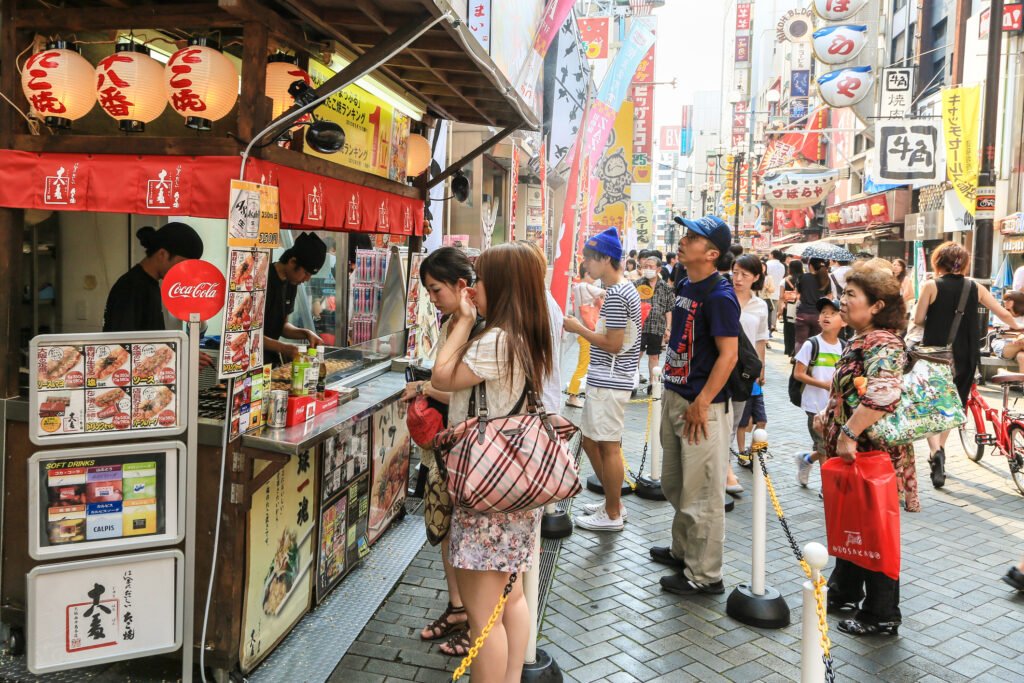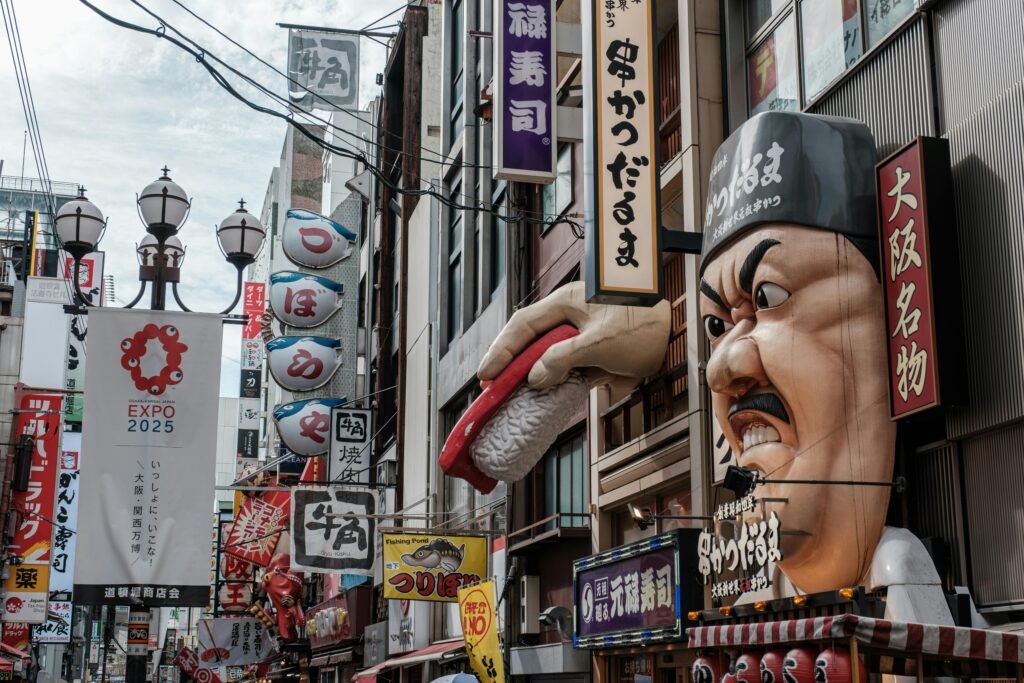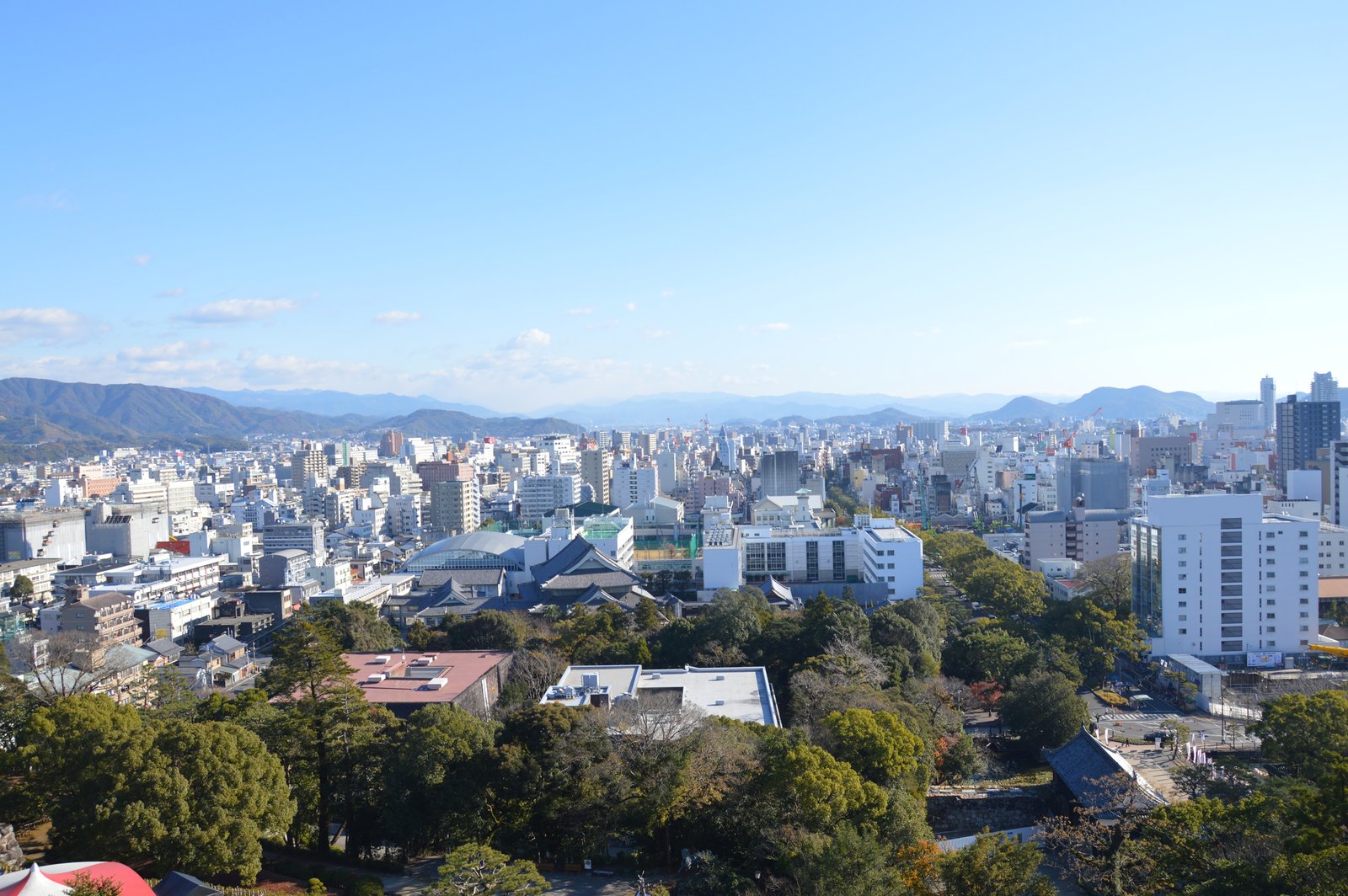Your journey into Japanese gastronomy begins from bustling markets and kitchens in Osaka. Known as “Japan’s kitchen,” culinary scene in this city is full of bold flavors. These flavors are different from Tokyo’s sleek dining.
From the tangy taste of street-side takoyaki to the smoky aroma of yakitori, Kansai cuisine is a story of tradition and passion. This Osaka food guide invites you to explore a world where every bite feels alive.
Unlike Tokyo’s refined elegance, this city celebrates unpretentious joy. Its culinary tour shows how fresh seafood, robust miso broths, and inventive okonomiyaki define Japanese gastronomy here. Whether you’re tracing the neon-lit alleys of Dotonbori or savoring a chef’s secret recipe, this guide map is the soul of Kansa’s table.
Ready to taste what makes city’s food culture unforgettable? Plan your Osaka journey with insights from those who live its flavors daily.

Key Takeaways
- Osaka’s culinary identity revolves around vibrant street food and family-owned eateries.
- Kansai cuisine prioritizes bold seasoning and seasonal ingredients over presentation.
- Iconic dishes like takoyaki and okonomiyaki embody Osaka’s playful, adventurous spirit.
- Local chefs emphasize freshness, often sourcing ingredients from Nipponbashi’s historic market.
- This guide balances cultural context with practical advice for immersive dining experiences.
First Taste of Osaka: A Perfect Food Journey
When you first arrive in this city, you feel like you open a treasure chest of flavors. You explored Tokyo’s fine dining before, but Osaka hits different. It offers a Japanese culinary journey that was real and authentic, not just about looks.
What Draws you to Osaka Culinary Scene
It all start with a conversation with Chef Hiroshi Sato of Kansai’s renowned kitchens. He says, “Osaka’s soul is in its street stalls, not Michelin stars.” These words spark your curiosity. You want to see beyond the stereotypes and find the Kansai flavor profile that is different from Tokyo’s elegance. The city’s “kuidaore” spirit, spend all you have on food; becomes your guide.
First Impressions of Kansai’s Distinctive Flavors
Your first try of okonomiyaki at a Shinsekai stall becomes amazing. The kushikatsu is crispy and has a tangy sauce. Takoyaki has a soft shell and a gooey center. These experiences change how you see Japanese food. It is bold, unapologetic, and all about sharing.
The Philosophy Behind Osaka Food Culture
City’s food culture comes from Edo-era merchants who made street snacks into art. This tradition is based on three key ideas:
- Accessibility: Dishes like takoyaki made luxury available to all
- Conviviality: Meals are shared, loud, and full of joy
- Heritage: Techniques are passed down with pride
Every meal teach you about Kansai’s belief in food as a way to bring people together. The Osaka food culture is more than just eating; it’s a way of life.
Understanding the Soul of Kansai Cuisine
In Osaka’s markets, the dashi flavor is key, blending kelp and fish flakes. It makes simple ingredients shine. Unlike Tokyo’s bold broths, Kansai’s dashi is soft, highlighting fresh veggies and seafood. This balance is what makes okonomiyaki and takoyaki special.

Traditional Osaka dishes simmering with Kansai cooking techniques
Kansai cooking is all about simplicity. Chefs believe in using just the right amount. This is seen in the perfect frying of kushikatsu and the slow cooking of miso soup. “The best meals,” one chef says, “show their true self in the first bite.”
“Umami isn’t just a taste. it’s a promise of authenticity.”
Here, food scene is shaped by its history as a merchant city. Bold flavors and big portions show generosity. Dishes like kushikatsu bring people together. For a taste of this, check out Epicurean Escape’s guided tours.
Here, tradition and skill come together to celebrate life’s simple pleasures. Each bite shares stories of land, sea, and centuries of love.
The Ultimate Culinary Tour of Osaka: Neighborhoods to Explore
Osaka’s food scene is more than just streets. It’s a story that comes alive. Every block is a feast for your senses. From neon canals to historic alleys, each area has its own secrets. Let’s explore where locals eat, discover, and enjoy.
Dotonbori: Neon Lights and Food Delights
Dotonbori’s canal is city’s culinary heart. Giant mascots call out above okonomiyaki griddles. At Dotonbori restaurants, you’ll find sizzling scallops at Kani Dote and smoky monjayaki at MoMoMo. Neon lights dance like a dream, and every corner offers a new taste.
Shinsekai: Old-World Charm and Street Food
Shinsekai lies under the Tsutenkaku Tower’s retro glow. Here, street food echoes Osaka’s 1920s. Kushikatsu at Kushikatsu Den is a tradition, golden skewers of tempura-battered pork or lotus root. It’s where street food meets tradition, and every bite feels like stepping into a vintage postcard.
Tenma: Off the Beaten Path Food Treasures
Tenma’s alleys are home to family-run izakaya with decades of kushikatsu mastery. A small udon stall and a century-old robatayaki grill are hidden gems. They thrive on loyalty, much like Tuscany’s hill towns.
Kitashinchi: High-End Dining Experiences
Kitashinchi offers sleek ryoutei for kaiseki mastery. At Naniwaya, each dish is a chef’s ode to Kansai’s riches. This district’s elegance mirrors Kyoto’s tea houses, yet it’s Osaka’s refined side, where tradition meets modern flair.
Street Food Sensations: Osaka’s Casual Eats
City’s food scene is alive in its markets and alleys. Osaka street food turns simple ingredients into masterpieces. Your explorations shows you the city’s creative and detailed side.

Osaka street food
Takoyaki: The Iconic Octopus Balls
Early mornings, you see vendors at takoyaki stands expertly making takoyaki. The balls crackle when you bite them, revealing soft octopus inside. Remember, add sauce and mayonnaise, and turn skewers slowly to avoid burns.
One stand, run by a couple for 40 years, adds yuzu to their batter. This shows how tradition can evolve.
Okonomiyaki: Savory Pancakes with Endless Variations
Osaka’s okonomiyaki is different from Hiroshima’s. Here, the batter and cabbage are mixed before cooking. At Misen, you learn to flip the pancake yourself, feeling the heat rise as you do.
Want to try something new? Okonomiyakko offers spicy mayo and truffle versions. They keep the dish’s essence while exploring new flavors.
Kushikatsu: Deep-Fried Skewers of Goodness
Kushikatsu restaurants make frying a show. They fry pork, zucchini, or melon in golden batter. At Kushikatsu Den, you learn to dip skewers in crispy shrimp tempura-style sauce.
Then, you can share plates with others at communal tables. The secret? Let skewers rest 30 seconds after frying to keep them crunchy.
Beyond the Streets: Exceptional Restaurant Experiences
City’s food scene goes beyond street food. In traditional Japanese restaurants, chefs create art with ingredients. Your first kappo cuisine meal at a small counter in Namba shows you how simple can be deep.
Watching a chef prepare hamo (conger eel) turns into a lesson in elegance. Its delicate texture and sea-breeze flavor become unforgettable.
| Dining Style | Experience | Example Dish |
|---|---|---|
| Kappō | Chef-prepared counter dining | Freshly shucked oyster sashimi |
| Kaiseki | Seasonal multi-course storytelling | Pine mushroom with yuzu gelée |
| Izakaya | Intimate group dining with sake pairings | Tororo tuna tataki |
| Modern Fusion | Innovative twists on classics | Matcha-infused dashi ramen |
“The fish here swims this morning, dies tonight,” says Chef Sato. His words echo city’s reverence for freshness.
Booking fine dining in Osaka needs planning. Use Osaka food reservations websites for Michelin-starred spots like Kinryu or cozy kappo counters. Remember, many top traditional Japanese restaurants need direct calls. Learn key phrases like “chūwan oshiki” (reservation) in advance.
These places are more than meals. They’re conversations between land and sea, tradition and new ideas. Whether it’s a 20-course kaiseki or grilled skewers at an izakaya, City’s tables share stories worth tasting.
The Markets of Osaka: Where Chefs and Locals Shop
In this city, markets are the heart of its food scene. Here, old traditions meet new ideas. Chefs and home cooks come together to learn and taste.

Osaka street food
Kuromon Ichiba Market: The Cook’s Paradise
At dawn, Kuromon Market comes alive. Over 150 stalls offer everything fresh. The air buzzes with the sound of haggling and the crunch of produce.
Fishmongers carve tuna with skill, their hands moving like artists. Vendors share samples, like silky tofu and sea urchin. A seafood stall owner once gave me grilled scallops, saying,
“This freshness? It’s why Osaka’s kitchens stay alive.”
Nipponbashi: Kitchen Tools and Culinary Inspiration
Nipponbashi turns food shopping into an art. It’s filled with Japanese cooking supplies. Hand-hammered knives and cast-iron pans tell stories of years of use.
A knife smith shows you how a santoku blade’s angle affects its cut. These tools are more than just items; they’re keys to mastering local cooking techniques.
Pro tips: Get to Kuromon early for the best experience. Nipponbashi’s tool shops offer free knife-sharpening demos. Ask vendors for their favorite spots for okaki snacks or miso pastes. Let your senses lead you to Osaka’s flavors.
Osaka’s Sweet Side: Desserts and Confections

Osaka confectioneries
In this city, culinary charm isn’t just in savory dishes. It also shines in sweets. The city’s dessert scene is a journey through time and taste. You can enjoy a cherry-blossom-shaped mochi in a century-old shop or a matcha-infused pastry in a trendy café. City’s confectioneries mix heritage with innovation.
Traditional Japanese Sweets in Osaka
Exploring wagashi shops like Nishimura Honpo, you discover Kansai’s unique flavor shaping. Their Japanese desserts in Osaka mix azuki bean paste’s sweetness with mochi’s chewiness. Each piece, like sakura-mochi, shows off seasonal themes, made for both the eyes and taste buds.
Modern Fusion Desserts That Surprise and Delight
In trendy spots like Midosuji, chefs update classics. A Kyoto-trained patissier shares:
“I layer yuzu curd between croissant layers—Kansai diners crave bold contrasts, not just harmony.”
Theirmodern Japanese pastries blend Kyoto’s grace with Parisian flair. Even simpleOsaka confectioneries surprise, like daifuku with wasabi white chocolate. It’s a mix of heat and creaminess in one bite.
Drinking Culture: Pairing Beverages with Osaka Cuisine
In this city, dining is more than just eating. At an izakaya, drinks are as important as the food. The tradition of pouring drinks first shows respect. All-you-can-drink sets make meals into fun gatherings.

Night view of Denden Town, Osaka, showcasing lively Japanese restaurants.
Sake in Osaka is special, with secrets known only to local brewers. Visiting Nada’s breweries, you learn about Kansai’s unique sake styles. They match perfectly with city’s street food.
Osaka’s craft beer is making its mark. Breweries like Kunisaki add yuzu or sansho to their IPAs. This creates a refreshing taste that goes well with Osaka’s fried foods.
“A good izakaya beverage menu tells a story. Start with a cold draft beer, then let the sake season the course,” says a sommelier at Kuromon Market’s tasting bar.
Even those who don’t drink have options. Yuzu sodas and matcha teas offer unique flavors. They show drink culture in this city is a journey for the senses.
- Pair rich dishes like okonomiyaki with bold yamahai sake
- Opt for craft beers using local ingredients like sansho pepper
- Ask servers about seasonal izakaya beverage menu specials
Seasonal Specialties: How the Calendar Influences the Osaka Table
Here, food scene changes with the seasons. Each time of year brings new flavors. Your first taste of spring’s bamboo shoot tempura shows you how chefs celebrate “shun,” the peak of freshness.
From sweet treats with cherry blossoms to warm nabe pots in winter, city’s dishes reflect nature’s changes. Let’s dive into how Osaka turns seasons into delicious meals.
| Season | Signature Dish | Key Ingredient |
|---|---|---|
| Spring | Osaka spring dishes (bamboo shoot tempura) | Bamboo shoots |
| Summer | Chilled somen noodles | Yuzu |
| Autumn | Matsutake rice bowls | Matsutake mushrooms |
| Winter | Traditional winter foods (oden) | Daikon radish |
Spring Delicacies in Kansai
In spring, fava beans and yudofu (simmered tofu) are fresh. Kuromon Market chefs offer dishes like hanumoki, a green tea kelp jelly. It’s a taste of spring.
At a stall, you’ll see how cherry petals turns into mochi. It’s a fleeting beauty enjoyed with matcha.
Summer Cooling Dishes
Summer brings icy dishes. Vendors serve somen noodles with yuzu broth. At a riverside stall, grilled unagi with sweet soy is a refreshing treat.
Autumn Harvest Offerings
Autumn brings dishes like sanma no nitsuke (grilled pacific saury). Matsutake mushrooms add an earthy flavor to autumn dishes. It’s a time of rich tastes.
Winter Comfort Foods
Winter’s warmth comes from oden and nabe pots. Traditional dishes like grilled kaki persimmons with spiced soy sauce are cozy. Try this pork ramen with a runny yolk for a hearty meal.
Every visit to Osaka is a new discovery. The Japanese food calendar is a living tradition, connecting land and plate.
Tips for American Travelers on an Osaka Food Adventure
Exploring food scene is more than just eating. These tips will guide you through the journey.
Navigating Dietary Restrictions
Finding vegetarian options in Osaka takes some effort. But, places like Tsuruhashi Market and T’s Tantan offer great choices. Always ask about the broth to ensure it’s vegetarian.
Using phrases like “shakushin teishoku ga dekimasu ka?” can help. It means “Can you prepare without meat?”
Etiquette for Dining in Osaka
Here, dining etiquette is a mix of tradition and friendliness. Here are some key rules:
- Always hold chopsticks correctly—never stick them in rice bowls.
- Accept an oshibori (wet towel) with both hands before using it.
- Finish all your food; it shows you appreciate the chef’s work.

Experience the vibrant nightlife of Osaka’s alleyway dining with people enjoying meals and socializing.
“A simple gochisousama deshita (thank you for the meal) at the end can lead to a special invitation.”
Japanese Menu Translation Hacks
Understanding menus is key to enjoying food. Here’s what you can use:
- Shūryō ryōri (set meals) for affordable and tasty meals
- Picture menus at kushikatsu shops to choose easily
- Translation apps to check for katsuo (fish stock) in vegetarian dishes
Ask questions like “kono ryōri no yōryō wa?” (“What ingredients are in this dish?”). Locals value your curiosity.
Conclusion: The Lasting Impression of Osaka’s Culinary Soul

Dynamic Dotonbori street view in Osaka highlighting bustling urban life with iconic signs and landmarks.
Osaka’s food culture leaves a lasting mark long after you leave. Your exploration of Kansai cooking shows you how Japanese traditions are in every dish. From the sound of takoyaki at Dotonbori to the skill of sushiya, it’s all about tradition and innovation.
Markets like Kuromon Ichiba are a perfect example. Here, old techniques meet modern desserts. It’s a place where tradition and new ideas come together.
Osaka’s food scene is more than just places to eat. It’s where people come together over food. Whether it’s kushikatsu or fresh ingredients, the focus is on quality. This shows a philosophy that goes beyond borders.
For those interested in food tourism, this city is a must-see. It shows how tradition and curiosity can go hand in hand. Here, you can taste stories of resilience and change.
Leaving Osaka, you take away more than just souvenirs. You gain a new way of seeing food. The city teaches you to value freshness, accept imperfections, and enjoy meals with others.
Its culinary soul teaches you that the best food nourishes both body and spirit. These lessons are as relevant in New York as they are in Osaka. Great food is a universal language that brings people together.


